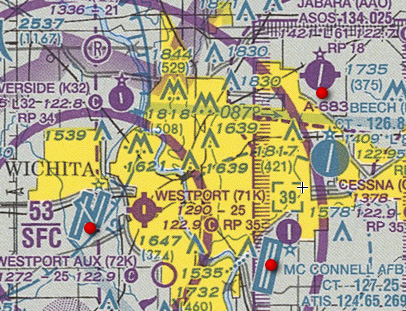A few years ago, I took an MPR News website producer for a ride in an airplane to show him his colleague's outstanding airmanship.
This is our approach to the airport in South St. Paul at the time. As we approach the Wakota Bridge, the speed is good, the engine is performing normally, seat belts secured, and it looks like this will be an uneventful landing. There's just one slight problem...

That's not the airport in South St. Paul. That's the downtown Saint Paul airport five miles away. The actual airport -- the runways point in roughly the same direction as most runways in Minnesota do -- is just off our left wing. I had, obviously, mistaken the two airports.
It happens, although usually not with a 747 cargo jet, like the one that landed by mistake at Wichita's Jabara Airport last night. It was supposed to land at McConnell Air Force Base, just a few miles away. The runways face the same direction. Stop me if you've heard this story before.
Here's the sectional map of Wichita that pilots refer to:

The goal of a flight crew is to match -- in the dark -- the lights below (on the map, the yellow indicates the pattern of the lights of Wichita) and the flickering lights of a runway (which can be extremely difficult to pick out when you're flying at night) and select the right one. They selected incorrectly, obviously.
There's no tower at the airport they landed at so there was no one to ask for permission to land and no one to say "you're at the wrong airport."
Sure, there are instruments that the pilots could've used -- and probably even an autopilot -- to land the jet at the right airport, but sometimes pilots like to fly the old fashioned way: by themselves. And, afterall, wasn't the news just talking about the problem of pilots being too dependent on computers?
There's not much you can do after landing at the wrong airport but say "whoops" and check the job listings.
The early news stories made a bigger deal out of the "problem" of getting the jet out. CBS, for example, said the plane was stranded because the runway is too short:
A Dreamlifter is supposed to need a runway 9,199 feet long to take off at maximum takeoff weight, and 7,000 feet to land at maximum landing weight. The runway at Jabara is 6,101 feet long.
That's an easy one to solve. Don't be at maximum takeoff weight. Take everything out (we don't even know if was carrying anything), point the thing in the right direction, and takeoff. They might have already done it by the time you read this.
The incident is similar to one last year when an Air Force cargo plane landed near Tampa, at a small airport half the size of the one in Wichita.
It took a few days to strip the plane of much of its weight.
"There's no way" they'll get the plane off the ground again, the person who took the video said.
Way.
Planes are built to fly; they don't know they're in the wrong spot.
